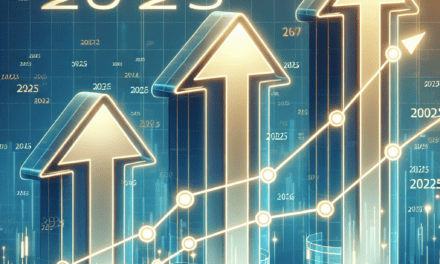“Navigating Uncertainty: Investors Brace for Election-Driven Market Waves in Stocks and Crypto”
Introduction
As the United States approaches another pivotal election, investors are bracing for potential volatility across financial markets, including both traditional stocks and the burgeoning cryptocurrency sector. Historically, elections have been periods of uncertainty, often leading to fluctuations in market sentiment and asset prices. This year, with heightened political polarization and economic challenges, the stakes are particularly high. Investors are closely monitoring policy proposals, regulatory shifts, and geopolitical tensions that could influence market dynamics. In anticipation of these events, many are adjusting their portfolios, seeking to hedge against risks while positioning themselves to capitalize on potential opportunities. The interplay between political developments and market reactions underscores the complex landscape that investors must navigate during this election cycle.
Understanding Market Volatility During US Elections
As the United States approaches another election cycle, investors are bracing for the potential volatility that often accompanies such significant political events. Historically, US elections have been periods of heightened uncertainty, which can lead to increased market fluctuations. This year, both traditional stock markets and the burgeoning cryptocurrency sector are under the spotlight as investors seek to navigate the complexities of election-induced volatility.
To understand why elections can lead to market volatility, it is essential to consider the factors at play. Elections introduce a degree of uncertainty regarding future economic policies, regulatory changes, and geopolitical relations. These uncertainties can cause investors to reassess their portfolios, leading to increased buying and selling activity. Consequently, markets may experience sharp price movements as investors react to new information and attempt to position themselves advantageously.
In the stock market, election-related volatility is often observed in sectors that are particularly sensitive to policy changes. For instance, healthcare, energy, and financial services are sectors that may experience significant fluctuations due to potential shifts in regulatory frameworks or government spending priorities. Investors in these sectors must remain vigilant, as policy proposals from candidates can have immediate and profound impacts on stock valuations.
Meanwhile, the cryptocurrency market, known for its inherent volatility, faces its own set of challenges during election periods. Unlike traditional markets, cryptocurrencies are not directly tied to any single economy or government. However, they are not immune to the broader market sentiment that elections can influence. Cryptocurrencies may experience volatility as investors react to potential regulatory changes or shifts in the global economic landscape that could arise from a new administration.
Moreover, the increasing institutional interest in cryptocurrencies adds another layer of complexity. As more traditional financial institutions and large-scale investors enter the crypto space, the market dynamics begin to mirror those of traditional assets. This convergence means that cryptocurrencies may increasingly respond to macroeconomic factors, including election outcomes, in a manner similar to stocks.
To mitigate the risks associated with election-induced volatility, investors often employ various strategies. Diversification remains a cornerstone of risk management, allowing investors to spread their exposure across different asset classes and sectors. By doing so, they can reduce the impact of adverse movements in any single investment. Additionally, some investors may choose to increase their cash holdings during election periods, providing them with the flexibility to capitalize on opportunities that arise from market dislocations.
Furthermore, options and futures contracts can serve as valuable tools for hedging against potential losses. These financial instruments allow investors to lock in prices or protect against downside risks, offering a degree of certainty in uncertain times. However, it is crucial for investors to thoroughly understand these instruments and their associated risks before incorporating them into their strategies.
In conclusion, as the US election approaches, investors across both traditional and cryptocurrency markets are preparing for potential volatility. By understanding the factors that contribute to market fluctuations during election periods and employing prudent risk management strategies, investors can better navigate the uncertainties that lie ahead. While elections inherently bring a degree of unpredictability, they also present opportunities for those who are well-prepared and adaptable. As always, staying informed and maintaining a long-term perspective are key to successfully weathering the storm of election-induced market volatility.
Strategies for Investors to Mitigate Election-Induced Risks
As the United States approaches another pivotal election, investors are bracing for potential volatility across both traditional stock markets and the burgeoning cryptocurrency sector. Historically, elections have been periods of uncertainty, often leading to fluctuations in market sentiment and asset prices. Consequently, investors are keenly aware of the need to adopt strategies that can mitigate the risks associated with such volatility. By understanding the dynamics at play and implementing prudent measures, investors can better navigate the complexities of election-induced market movements.
To begin with, diversification remains a cornerstone strategy for managing risk. By spreading investments across a variety of asset classes, sectors, and geographies, investors can reduce their exposure to any single source of volatility. In the context of an election, this might mean balancing holdings between equities and fixed-income securities, or even incorporating alternative investments such as real estate or commodities. Additionally, within the stock market, diversifying across sectors that may react differently to political developments can provide a buffer against sector-specific downturns.
Moreover, maintaining a long-term perspective is crucial during election periods. While short-term market reactions can be unpredictable, historical data suggests that markets tend to stabilize over time. Investors who focus on long-term goals and resist the urge to make impulsive decisions based on election outcomes are often better positioned to weather temporary market disruptions. This approach is particularly relevant in the cryptocurrency market, where volatility is inherently higher, and price swings can be more pronounced.
In addition to diversification and a long-term outlook, investors should consider employing hedging strategies to protect their portfolios. Options and futures contracts can serve as effective tools for managing risk, allowing investors to lock in prices or offset potential losses. For instance, purchasing put options on key stock indices can provide downside protection in the event of a market downturn. Similarly, in the crypto space, investors might explore the use of stablecoins or derivatives to hedge against price volatility.
Furthermore, staying informed about political developments and potential policy changes is essential for investors during election cycles. Understanding the platforms and proposals of major candidates can offer insights into which sectors or industries might be impacted by the election outcome. For example, a candidate advocating for increased infrastructure spending could benefit construction and materials companies, while a focus on renewable energy might boost the prospects of clean energy stocks. In the realm of cryptocurrencies, regulatory stances can significantly influence market dynamics, making it imperative for investors to monitor policy discussions closely.
Finally, maintaining liquidity is a prudent strategy during times of uncertainty. By ensuring that a portion of their portfolio is held in cash or cash-equivalents, investors can quickly respond to market opportunities or challenges as they arise. This flexibility can be particularly advantageous in volatile markets, where rapid shifts in sentiment can create both risks and opportunities.
In conclusion, while elections inevitably introduce a degree of uncertainty into financial markets, investors can adopt a range of strategies to mitigate associated risks. Through diversification, a long-term perspective, hedging, informed decision-making, and maintaining liquidity, investors can better position themselves to navigate the complexities of election-induced volatility. By doing so, they not only protect their portfolios but also enhance their ability to capitalize on potential opportunities that may arise in the aftermath of the election.
Historical Analysis: How Past US Elections Impacted Stocks and Crypto
As investors brace for the upcoming US election, a historical analysis of past elections provides valuable insights into how such political events have impacted both the stock market and the burgeoning cryptocurrency sector. Understanding these patterns is crucial for investors seeking to navigate the potential volatility that elections often bring. Historically, US elections have been periods of heightened uncertainty, which can lead to increased market volatility. This is primarily due to the potential for significant policy shifts that can affect various sectors differently. For instance, the stock market has often experienced fluctuations in the months leading up to an election, as investors attempt to anticipate the outcome and its implications for fiscal and regulatory policies.
Looking back, the 2008 election, which resulted in Barack Obama’s presidency, occurred during the global financial crisis. The stock market was already experiencing significant turmoil, but the election brought additional uncertainty. However, once the election concluded and policies became clearer, the market began to stabilize and eventually recover. Similarly, the 2016 election, which saw Donald Trump elected, was marked by significant market volatility. The unexpected outcome led to an initial market dip, followed by a rapid recovery as investors adjusted to the anticipated pro-business policies of the new administration.
In contrast, the cryptocurrency market, which is relatively nascent compared to traditional stocks, has shown a different pattern of response to US elections. Cryptocurrencies, such as Bitcoin, have often been viewed as a hedge against traditional market volatility and political uncertainty. During the 2016 election, Bitcoin experienced a surge in value, as investors sought refuge from the unpredictability of the stock market. This trend was also observed during the 2020 election, where Bitcoin’s value increased significantly in the months surrounding the election, driven by both political uncertainty and broader economic factors such as the COVID-19 pandemic.
Moreover, the regulatory environment for cryptocurrencies remains a critical factor that can be influenced by election outcomes. Different administrations have varied in their approach to cryptocurrency regulation, with some advocating for stricter controls and others promoting innovation and growth within the sector. This regulatory uncertainty can lead to increased volatility in the cryptocurrency market during election periods, as investors speculate on potential policy changes.
As the upcoming election approaches, investors are keenly aware of these historical patterns and are preparing for potential market fluctuations. Diversification remains a key strategy, as it allows investors to mitigate risks associated with political uncertainty. Additionally, some investors are turning to alternative assets, such as cryptocurrencies, to hedge against potential stock market volatility. However, it is essential to recognize that while historical trends provide valuable insights, each election is unique, and various factors can influence market outcomes.
In conclusion, the historical analysis of past US elections reveals that both the stock and cryptocurrency markets are susceptible to volatility during these periods. While the stock market often experiences fluctuations due to anticipated policy changes, the cryptocurrency market may react differently, driven by its role as a hedge against uncertainty and its sensitivity to regulatory developments. As investors prepare for the upcoming election, understanding these historical patterns can aid in making informed decisions and navigating the potential volatility that lies ahead.
Diversifying Portfolios Ahead of Election Uncertainty

As the United States approaches another pivotal election, investors are bracing for potential market volatility that could impact both traditional stocks and the burgeoning cryptocurrency sector. Historically, elections have been periods of uncertainty, often leading to fluctuations in financial markets as investors react to potential policy changes and shifts in economic priorities. This year, with the added complexity of a rapidly evolving global economic landscape, the stakes are particularly high. Consequently, many investors are taking proactive steps to diversify their portfolios, aiming to mitigate risks and capitalize on potential opportunities.
Diversification, a fundamental strategy in risk management, involves spreading investments across various asset classes to reduce exposure to any single asset’s volatility. In the context of the upcoming election, this strategy is gaining renewed attention. Investors are increasingly looking beyond traditional equities, considering a mix of assets that include bonds, commodities, and real estate. These asset classes often behave differently under varying economic conditions, providing a buffer against market swings that might arise from election-related uncertainties.
Moreover, the rise of cryptocurrencies as a legitimate asset class has added a new dimension to diversification strategies. Cryptocurrencies, known for their volatility, present both risks and opportunities. While some investors remain cautious, others see digital currencies as a hedge against traditional market fluctuations. The decentralized nature of cryptocurrencies, coupled with their growing acceptance in mainstream finance, makes them an attractive option for those looking to diversify their portfolios further. However, it is crucial for investors to conduct thorough research and consider their risk tolerance before venturing into this relatively nascent market.
In addition to diversifying across asset classes, investors are also paying close attention to sector-specific strategies. Certain sectors, such as technology and healthcare, have shown resilience and growth potential, even amid economic uncertainties. The technology sector, driven by rapid innovation and digital transformation, continues to attract significant investment. Meanwhile, the healthcare sector, buoyed by ongoing advancements and increased demand for services, offers promising opportunities. By strategically allocating resources to these sectors, investors can position themselves to benefit from long-term growth trends, regardless of short-term election-induced volatility.
Furthermore, international diversification is gaining traction as investors seek to mitigate domestic risks by exploring opportunities in global markets. By investing in foreign equities and bonds, investors can tap into growth potential in emerging markets and benefit from currency diversification. This approach not only spreads risk but also allows investors to capitalize on global economic trends that may not be directly influenced by the US election.
In preparation for potential election volatility, investors are also emphasizing the importance of maintaining liquidity in their portfolios. Having readily accessible funds allows investors to respond swiftly to market changes, whether to seize opportunities or to protect against losses. This flexibility is particularly valuable in uncertain times, enabling investors to adapt their strategies as new information emerges.
In conclusion, as the US election approaches, investors are keenly aware of the potential for market volatility and are taking strategic steps to safeguard their portfolios. By diversifying across asset classes, sectors, and geographies, and by maintaining liquidity, they aim to navigate the uncertainties ahead with confidence. While the outcome of the election remains uncertain, a well-diversified portfolio can provide a measure of stability and resilience, helping investors weather the storm and emerge stronger in the long run.
The Role of Safe-Haven Assets in Election Year Investing
As the United States approaches another pivotal election year, investors are increasingly focused on the potential volatility that could impact both traditional stock markets and the burgeoning cryptocurrency sector. Historically, election years have been characterized by heightened uncertainty, as market participants attempt to anticipate the economic policies and regulatory changes that may follow a shift in political power. In this context, the role of safe-haven assets becomes particularly significant, offering a refuge for investors seeking to mitigate risk and preserve capital amidst the turbulence.
Safe-haven assets, such as gold, U.S. Treasury bonds, and certain currencies like the Swiss franc, have long been favored by investors during periods of market instability. These assets are typically perceived as stable and reliable, maintaining or even increasing in value when other investments falter. The appeal of safe-haven assets lies in their ability to provide a hedge against market volatility, offering a degree of security when uncertainty looms large. As the election approaches, many investors are likely to increase their allocations to these assets, seeking to balance their portfolios against potential market swings.
In recent years, the rise of cryptocurrencies has introduced a new dimension to the concept of safe-haven investing. While digital currencies like Bitcoin are often lauded for their decentralized nature and potential to act as a hedge against inflation, their volatility can rival that of traditional equities. Nevertheless, some investors view cryptocurrencies as a modern alternative to traditional safe-haven assets, particularly in an era where digital finance is gaining prominence. The debate over whether cryptocurrencies can truly serve as a safe haven continues, with proponents highlighting their independence from government control and critics pointing to their price instability.
The interplay between traditional safe-haven assets and cryptocurrencies is further complicated by the evolving regulatory landscape. As governments worldwide grapple with the implications of digital currencies, regulatory developments can significantly impact their perceived safety and attractiveness. In the United States, the outcome of the upcoming election could influence the regulatory approach to cryptocurrencies, potentially affecting their role as a safe-haven asset. Investors must therefore remain vigilant, monitoring both political developments and regulatory signals to make informed decisions.
Moreover, the broader economic context cannot be ignored. Factors such as inflation, interest rates, and global economic conditions will also play a crucial role in shaping investor behavior during the election year. For instance, rising inflation could enhance the appeal of gold and other tangible assets, while changes in interest rates might affect the attractiveness of bonds. In this complex environment, investors must carefully assess the interplay of these factors, considering how they might influence the relative safety and performance of various asset classes.
In conclusion, as investors brace for potential volatility in the lead-up to the U.S. election, the role of safe-haven assets remains a critical consideration. While traditional assets like gold and bonds continue to offer stability, the emergence of cryptocurrencies presents both opportunities and challenges. Navigating this landscape requires a nuanced understanding of market dynamics, regulatory developments, and broader economic trends. By strategically incorporating safe-haven assets into their portfolios, investors can better position themselves to weather the uncertainties of an election year, safeguarding their investments against the unpredictable tides of political change.
Analyzing Crypto Market Trends During Political Events
As the United States approaches another pivotal election cycle, investors are keenly aware of the potential volatility that political events can inject into financial markets. Historically, elections have been periods of uncertainty, often leading to fluctuations in both traditional and emerging asset classes. Among these, the cryptocurrency market has garnered significant attention due to its unique characteristics and growing influence. Understanding how political events, such as elections, impact the crypto market is crucial for investors seeking to navigate these turbulent times.
To begin with, it is essential to recognize that cryptocurrencies, unlike traditional stocks, are not directly tied to any single country’s economic performance or political stability. However, they are not immune to the broader market sentiments that elections can stir. For instance, during periods of political uncertainty, investors often seek safe-haven assets, traditionally turning to gold or government bonds. In recent years, Bitcoin and other cryptocurrencies have been increasingly viewed as digital alternatives to these traditional safe havens. This perception can lead to increased demand and price volatility in the crypto market during election periods.
Moreover, the regulatory environment surrounding cryptocurrencies is a significant factor that can be influenced by election outcomes. Different political parties and candidates may have varying stances on cryptocurrency regulation, ranging from supportive to restrictive. Investors closely monitor these positions, as regulatory changes can have profound implications for the market. For example, a government perceived as crypto-friendly might encourage investment and innovation in the sector, potentially driving prices upward. Conversely, a more stringent regulatory approach could lead to market apprehension and sell-offs.
In addition to regulatory considerations, the broader economic policies proposed by candidates can also impact the crypto market. Policies that affect inflation, interest rates, and fiscal spending can indirectly influence cryptocurrency prices. For instance, expansive fiscal policies that lead to increased inflation may bolster the appeal of cryptocurrencies as a hedge against currency devaluation. On the other hand, policies aimed at strengthening the national currency could reduce the attractiveness of digital assets.
Furthermore, the global nature of cryptocurrencies means that US elections can have ripple effects across international markets. As the US is a major player in the global economy, its political decisions can influence investor sentiment worldwide. This interconnectedness means that political events in the US can lead to synchronized movements in crypto markets across different regions. Investors must therefore consider not only domestic political developments but also their potential global implications.
In light of these factors, investors are advised to adopt a strategic approach when navigating the crypto market during election periods. Diversification remains a key strategy, allowing investors to spread risk across different asset classes and reduce exposure to any single market event. Additionally, staying informed about political developments and understanding their potential impact on market dynamics is crucial. By doing so, investors can make more informed decisions and better position themselves to capitalize on opportunities or mitigate risks.
In conclusion, while the cryptocurrency market operates independently of traditional financial systems, it is not isolated from the effects of political events such as US elections. The interplay between regulatory considerations, economic policies, and global market sentiment can create a complex landscape for investors. By analyzing these trends and adopting a proactive approach, investors can better prepare for the volatility that often accompanies election cycles, ensuring they remain resilient in the face of uncertainty.
Expert Predictions: Navigating the 2024 US Election Market Volatility
As the 2024 United States presidential election approaches, investors are bracing for a period of heightened market volatility, a phenomenon that has historically accompanied major political events. The anticipation of potential policy shifts and economic reforms often leads to uncertainty, prompting investors to reassess their portfolios. This year, the stakes are particularly high, as the election’s outcome could significantly impact both traditional stock markets and the burgeoning cryptocurrency sector. Experts are offering insights into how investors might navigate this turbulent period, emphasizing the importance of strategic planning and diversification.
Historically, stock markets have experienced fluctuations in the lead-up to and aftermath of presidential elections. Investors often react to the perceived economic policies of the candidates, with sectors such as healthcare, energy, and technology being particularly sensitive to potential regulatory changes. In the current climate, where inflation concerns and interest rate adjustments are already influencing market dynamics, the election adds another layer of complexity. Analysts suggest that investors should closely monitor candidates’ policy proposals, especially those related to taxation, trade, and fiscal spending, as these could have direct implications for corporate earnings and market sentiment.
In addition to traditional equities, the cryptocurrency market is also expected to experience volatility as the election draws near. The regulatory environment for digital assets remains uncertain, with differing views on how cryptocurrencies should be integrated into the financial system. The election could bring about significant changes in this regard, depending on the administration’s stance on digital currencies. Investors in this space are advised to stay informed about potential regulatory developments and to consider the long-term viability of their crypto investments. Diversification within the crypto market, as well as between crypto and traditional assets, may help mitigate risks associated with sudden regulatory shifts.
Moreover, geopolitical considerations are likely to play a crucial role in shaping market reactions during the election period. The United States’ relationships with major economies, such as China and the European Union, could be influenced by the election outcome, affecting global trade and investment flows. Investors should be aware of how foreign policy stances might impact international markets and, by extension, their portfolios. Keeping an eye on global economic indicators and geopolitical developments can provide valuable context for making informed investment decisions.
In light of these factors, financial advisors are recommending a cautious yet proactive approach to portfolio management. This includes maintaining a balanced asset allocation that aligns with individual risk tolerance and investment goals. While some investors may be tempted to make significant changes to their portfolios in response to election-related news, experts caution against overreacting to short-term market movements. Instead, they advocate for a focus on long-term investment strategies that can withstand periods of volatility.
In conclusion, the 2024 US presidential election presents both challenges and opportunities for investors across stocks and cryptocurrencies. By staying informed about policy proposals, regulatory developments, and geopolitical dynamics, investors can better position themselves to navigate the uncertainties of this election cycle. Strategic diversification and a long-term perspective are key to managing risk and capitalizing on potential market shifts. As the election unfolds, maintaining a disciplined investment approach will be essential for weathering the inevitable market fluctuations and achieving financial objectives.
Q&A
1. **Question:** How are investors preparing for potential volatility in the stock market due to the US election?
– **Answer:** Investors are diversifying their portfolios, increasing cash reserves, and using options strategies like puts and calls to hedge against potential market swings.
2. **Question:** What specific strategies are being used in the crypto market to manage election-related volatility?
– **Answer:** In the crypto market, investors are using stablecoins to reduce exposure to volatility, employing stop-loss orders, and engaging in futures and options trading to hedge risks.
3. **Question:** How might the outcome of the US election impact stock market sectors differently?
– **Answer:** Different sectors may react variably; for example, renewable energy stocks might benefit from a Democratic win, while defense and oil sectors could see gains with a Republican victory.
4. **Question:** What role do geopolitical concerns play in investor strategies during the US election period?
– **Answer:** Geopolitical concerns, such as trade policies and international relations, are leading investors to consider global diversification and to monitor foreign markets closely for potential impacts.
5. **Question:** How are institutional investors adjusting their strategies in anticipation of election volatility?
– **Answer:** Institutional investors are increasing their focus on risk management, employing algorithmic trading to quickly respond to market changes, and consulting political analysts to better understand potential outcomes.
6. **Question:** What historical trends are investors considering when preparing for election-related market volatility?
– **Answer:** Investors are examining past election cycles, noting that markets often experience increased volatility and uncertainty, but typically stabilize after the election results are clear.
7. **Question:** How are retail investors being advised to handle their investments during the election period?
– **Answer:** Retail investors are being advised to stay informed, avoid making impulsive decisions, maintain a long-term perspective, and consider consulting financial advisors for personalized strategies.
Conclusion
Investors are bracing for heightened volatility in both stock and cryptocurrency markets as the US election approaches. Historically, elections can lead to uncertainty, prompting market fluctuations due to potential policy changes and shifts in economic direction. In anticipation, investors are diversifying portfolios, increasing cash reserves, and utilizing hedging strategies to mitigate risks. The crypto market, known for its volatility, may experience amplified movements as investors react to election outcomes and regulatory prospects. Overall, the election period is expected to be a critical time for market participants, requiring careful navigation and strategic planning to manage potential volatility.





